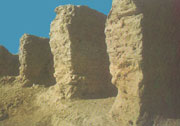|
Lop Lake-Lake of death
 The Lop Lake , which is located in the east of the Takelamagan Desert in China's Xinjiang Ugur Autonomous Region, attracts historians and geographers from home and abroad by its mystery. The Lop Lake , which is located in the east of the Takelamagan Desert in China's Xinjiang Ugur Autonomous Region, attracts historians and geographers from home and abroad by its mystery.
Lop Lake, also called Lop Nur, was named Youze in "Shanhaijing" (the Classic of Mountains and Seas), a famous Chinese geographical book written in the pre-Qin days (21st century AD -AD 221). Lop Nur is the Mongolian transliteration, which means a lake where waters gather. It was described in "Hanshu" (History of the Han Dynasty) that the lake covers a large area of 300 square lis with water never rising in summer or dropping in winter.
In Qing Dynasty(1616 BC£1911 BC), a man called Amida went deep into the lake area and described in the 9th volume of his book The River Sources and the Names of the Land: Lop Nur is a huge lake in the northeast of the Western Regions (a Han Dynasty term for the area west of Yumenguan), where six or seven rivers gather from the west. The river system covers an area 5000km2 and stretches 4,500 li, not including the underground waterways in deserts. All the nearby rivers wind into Lop Nur, which is over 200 li from east to west and more than 100 li from south to north. The lake level never rises in summer or drops in winter¡
The Chinese geographer Xusong marked out in the illustrations of his book that the Tarim River flew into the Peacock River and down to the Lop Lake. Man from all over the world investigated the lake and left their brilliant descriptions about it, to name some, Italian merchant Marco Polo, Russian adventurer H.M.Purshiwarski, Swedish geographer Sevin Hedin, an American man Gordington, an Englishman Ian Stein, a Japanese man Kiricho and a Frenchman Bonwalo, etc.
In 1930-1934, Chinese scientists Huang Wenbi and Chen Congqi made a field trip to Lop Lake and drew a map about the lake. In 1959 and 1980-1981, the Chinese Academy of Sciences organized large-scale investigations to Lop Lake. During an investigation in May to July in 1980, Comrade Peng Jiamu died in the region of Kumukuduke when looking for water source.
Once there was a much developed ancient kingdom-the Kingdom of Loulan with a big population. In AD 126, after his trip to the Western Regions, Zhangqian (a Chinese explorer of the Silk Road in the Han Dynasty) reported to the emperor that the Kingdom of Loulan had city walls around its capital and was near a salt lake. The kingdom was strategic passage to the southern part of the well-known Silk Road.
Before long, the booming Loulan Kingdom disappeared without any notice. The once prosperous southern Silk Road became a land of sand that made trips difficult. The vast lake of Lop Lake was turned into a dry salt marsh.
On the pictures taken by the satellites, Lop Lake today is just a desolate land with rings and rings of salt shells. This living example of the disappearance of a huge lake gives us a warning that we should put the environmental protection as the first and most important goal when developing those ecologically fragile regions in the west.
Lugu Lake-The living specimen of the matriarchal society <<
Poyang Lake-the ancient battlefield >>
|